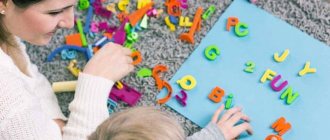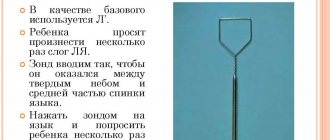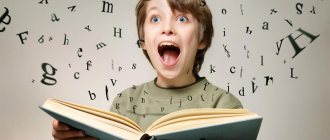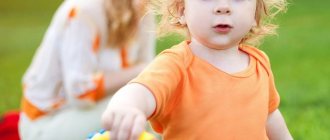Games to automate the sounds S and S using phrases as examples
"Come here"
This game is for several children, but it can also be played in pairs. Before this, just show a small performance with the participation of toys.
Choose toys that have the sound S in their names, for example, a dog, a Sasha doll, an owl, an elephant. Tell us how the toys played this game. For example, a dog says: Doll Sasha, come here! I found you a comb!” The doll Sasha says: “Elephant, come here!” I found you a scooter!” Next, the toy addresses the child, and then the child addresses different toys and says what he found for them. The main thing is that the word must contain S or S'.
Breathing exercises for 1st and 2nd junior groups of preschool educational institutions
"In the shop"
Collect objects and images that have a whistling S or S in them. We have an unusual store; you can only get goods there if you correctly pronounce the name of the product and where it is located. When pronouncing, the child must pronounce the sound we need for a long time. For example:
- Hello! - Hello! What would you like to buy from us? - I want a bowl! – To buy a bowl from us, tell me where the S is in the word? – In the word missssska the sound C is in the middle! - Right! Here's your bowl. - Thank you! Goodbye! - Goodbye! Come to us again!
Article:
Goal: to introduce parents to the principles and techniques of automating delivered sounds at home.
Consultation progress
- Introductory conversation.
By regularly attending speech therapist classes, the sound pronunciation of a preschooler can acquire the character of “office speech,” when in the speech therapist’s office (or when asked to repeat correctly) the sounds are clear, but in free speech the child pronounces the same sounds distorted. This indicates that the process of sound pronunciation correction is at the “automation” stage. The speed of passing this stage depends on the frequency of completing homework aimed at automating the assigned sounds. Ideally, daily automation training is required for at least 5-15 minutes a day.
- General provisions.
Automate sound - introduce it into syllables, words, sentences, coherent speech. From a physiological point of view, the stage of sound automation is the consolidation of conditioned reflex speech-motor connections on various speech material. The delivered sound is still very fragile; the conditioned reflex connection without reinforcement can quickly collapse.
You can move on to automating a given sound only when the child pronounces it in isolation completely correctly and clearly with prolonged or repeated repetition, that is, when the speech therapist “set” this sound for the child. In no case should you introduce into syllables and words a sound that is not yet pronounced clearly enough, as this will only lead to the consolidation of incorrect skills and will not improve pronunciation.
Sound automation is carried out according to the principle from easy to difficult, from simple to complex and is carried out in a strict sequence:
- automation of sound in syllables (direct, reverse, with a combination of consonants);
- automation of sound in words (at the beginning of the word, middle, end);
- automation of sound in sentences;
- automation of sound in tongue twisters, tongue twisters and poetry;
- automation of sound in short and then long stories;
- automation of sound in spoken language.
You can move on to new material only if you have mastered the previous one.
- Stages and techniques for automating delivered sounds in speech.
Automation of sound in syllables.
A syllable is a simpler speech unit compared to a word. In addition, the syllables are meaningless; therefore, the child does not have stereotypes in the pronunciation of words, which facilitates their automation.
Automation of sounds begins with direct open syllables, then continues in reverse and closed syllables. Later, the pronunciation of sounds in syllables with a combination of consonants is practiced.
For example, when automating the sound [S] in syllables, we connect the fixed consonant with the vowels [a], [s], [o], [u] first in direct syllables: sa, sy, so, su, then in reverse ones: as, ys, os, us, then into syllables where the sound is between vowels: asa, asy, aso, asu, ysa, and finally into syllables with a combination of consonants (those consonant sounds that are not impaired in the child are taken): hundred, hundred, spa, sma, dreams, sko.
Automation of sounds in words.
Automation in words is first carried out based on syllables (sa - sad). At the initial stages, the pronunciation of words in which the given sound is at the beginning of the word is consolidated, then words in which the sound is at the end and middle of the word.
To automate sound, they use the techniques of reflected repetition, independent naming of words from a picture, and reading of words.
Useful tasks that direct the child to search for words containing a given sound (inventing words with a given sound).
Try to introduce creative exercises, games, and move from pronouncing individual words to constructing phrases with them and short statements.
Automating sounds in words is the development of a new skill that requires long-term systematic training. Therefore, for each position of a sound in a word - at the beginning, middle, end - select 20-30 pictures (you can draw a diagram yourself). During one lesson, 10–16 words are given, and each is pronounced 4–5 times, emphasizing the automated sound (it is pronounced longer and exaggerated).
At this stage, work is also carried out on complex forms of sound analysis and synthesis, to develop the ability to isolate a sound in a word, determine its place in relation to other sounds (after which sound, before which sound). This work contributes to the efficiency of the automation process. The ability to clearly and quickly determine the sound structure of a word is necessary for the correct and rapid completion of the automation stage.
Automation of sound in sentences.
Automation of sound in sentences is carried out on the basis of practiced words, in the same sequence. At first, sentences with moderate inclusion of sound are offered; later, automation is carried out on speech material saturated with this sound (each word of the sentence contains an automated sound).
Automation of sound in pure tongue twisters, tongue twisters and poetry.
Children are asked to repeat or memorize phrases, tongue twisters and poems.
- Games for automating set sounds at home.
Learn to play with your child, using any suitable moment for this.
Working on sound, from its production to its use in independent speech, is the development of a new complex skill. And like any skill, it requires effort, time and a certain system in practice, including when doing homework.
I offer you several interesting games that can be used, starting from the stage of automating sounds in words.
"Puzzles"
For this game you will need: 6-7 pictures or toys, the name of which contains a sound. Together with your child, name them, highlighting the desired sound with your voice. Then describe any of them, the child must guess what it is about and name the desired picture or toy. Repeat the game several times. Now offer your child the role of leader. Your possible mistakes will certainly increase your child’s interest in the game.
“What’s missing?”
You can use the same pictures or toys. Invite your child to carefully look at the pictures again, name them, remember them and close their eyes. At this time, remove one or two pictures. The child, opening his eyes, must say what is missing. Repeat the game several times, changing roles with your child.
"What changed?"
This is one of the variants of the previous game. You can change the places of the pictures, remove them, turn the pictures over, add new ones. The child must tell about all changes.
“What’s extra?”
Select pictures so that they can be grouped according to different criteria (you can use pictures from lotto, choosing from them those whose names have the desired sound). Ask your child to find and name the extra object and explain his choice.
You can combine pictures into groups in different ways. For example, lynx-cow-crow-giraffe-rocket. From this series you can successively remove the “rocket” - inanimate, then the “crow” - a bird, then the “cow” - a domestic animal. Invite the child to compare the two remaining pictures (giraffe and lynx) and say how they are similar and how they differ, i.e. try to find and describe in detail the features of two similar objects.
"Words Around Us"
Ask your child to look carefully around and name all the objects whose names contain the desired sound. Say the words one by one, don’t forget to make mistakes sometimes and give your child the opportunity to notice your mistake and correct it.
Then complicate the game - remember words with a fixed sound on a specific topic: “Name the animals whose names have the sound [R]” (zebra, rhinoceros, tiger, panther, kangaroo, giraffe) or “Name the “winter” word with sound [S]" (snow, snowman, Snow Maiden, bullfinch, snowballs, cold, sleigh).
You can play this game anywhere, using any free minute: on the way to kindergarten, in transport, in line. You can play this game with a ball at home.
Gradually, imperceptibly for himself, the child begins to correctly pronounce the sound being reinforced not only in individual words, but also in phrases. The phrase should contain as many words as possible with the desired sound. It is better if the child himself comes up with phrases, first with your help, and then without it. It's even better if you come up with short, funny poems. They are easy to remember, and the child willingly tells them to everyone - family and friends.
The most useful thing for a child is your genuine interest in joint activities and joy for his success. Let the activities bring joy to the baby - the result largely depends on this.
Games for phonemic perception of sounds С and Сь
Game “Clapping”
Invite your child to clap his hands when he hears S or S in the words. Pronounce words where this sound occurs at the beginning, in the middle and at the end of words and words where S is absent altogether. If it is difficult for a child to hear, extend the sound, for example, masssslo, sssssergi, rysssss.
You can complicate the game and ask the child to clap on the sound C and stamp on S.
Game “What is that whistling, guess”
You will need a picture of a pump and a faucet with water flowing out of it. Show the child the first picture and say: “The air comes out of the soda and whistles S-S-S-S-S-S-S-SC.” Let the baby repeat.
Articulation gymnastics for the sounds Ш and Ж
Next we show the second picture: “Water flows from the tap and whistles softly, like this.” The child repeats.
Now we show him the pictures one by one and ask him to say how the water whistles.
We give the child pictures and play as follows: you say the sounds mixed together: s-s-s-s-s-s-s-s, and he shows you the correct image. Next, instead of sounds, you can name words where S and Sj occur.
Joke game “Confusion”
Invite your child to guess which words should appear with the sound S or S in the place of the error. For example:
- We ate a robe in the kindergarten. And Mashki is a beautiful salad.
- A bench was flying across the sky. And there was a seagull in the yard.
- They said that a fisherman caught dogs in the river. But then he was hooked by a gnome. (Not a house, but a catfish).
- Vaska is lying on a cot, gnawing on his ears. (Not guns, but dryers).
- The doll's daughter is beautiful! My daughter has a long goat! (not a goat, but a scythe).
Children really like this game, they laugh, but correct mistakes.
Experience of a kindergarten speech therapist in learning vowel sounds using hands
Learning vowel sounds with the help of hands
Author: teacher - speech therapist, Svetlana Vyacheslavovna Klokova, MBDOU d/s. No. 39, Arzamas, Nizhny Novgorod region. Description: The author's methodological development for the study of vowel sounds using a number of manual postures (bioenergoplasty) will help in an interesting playful way to develop joint movements of the hands and articulatory apparatus, develop children's speech and mental activity, coordination of movements and fine motor skills. It will be useful for speech therapists, special education teachers, and interested parents. Goal: automation of vowel sounds. Tasks: - automate vowel sounds; — develop articulatory and fine motor skills; - develop speech and thinking activity; - develop coordination of movements; - arouse interest in the activity.
My profession is speech therapist.
Work experience is more than 20 years, in a group with children with general speech underdevelopment - 15 years. Recently, health-saving technologies have become very popular among teachers in their work. This is caused by the annual increase in children with various speech pathologies. Our task is not only to preserve the health of children, but also to take care of their positive development dynamics. Children with any speech impediment, such as phonetic underdevelopment (PH), phonetic-phonemic underdevelopment (FFN), general speech underdevelopment (GSD), especially a complicated dysarthric component, need to begin classes to correct sound pronunciation with articulatory gymnastics. It will help prepare the organs of articulation (tongue, lips, lower jaw, cheeks) for the upcoming work of producing sounds. It will strengthen the muscles or, conversely, relieve excess tension in them. From my many years of work experience, I came to the conclusion that it is necessary to use not just articulatory gymnastics in the work of a speech therapist, but to connect it with synchronous movements of the hands. The posture of the hands, as it were, shows the position of the posture of the articulation exercise. This area of health-saving technology is called “bioenergoplasty”. The interaction of speech and motor activity stimulates the development of areas of the brain responsible for speech, helping to maintain articulatory postures longer and better. Anyone can get acquainted with my articulatory gymnastics using bioenergoplastics on the ped-kopilka website by following the link/blogs/svetlana-vjacheslavovna-klokova/artikuljacionaja-gimnastika-s-primeneniem-bioyenergoplastiki-po-teme-zhivotnye.html. At the same time as articulatory gymnastics, combining movements with hand posture, I begin to study vowel sounds with the children using bioenergoplasty. Now the posture of the hands repeats the posture of the articulated sound. If a child has a complex speech pathology, the speech therapist begins corrective work to correct pronunciation deficiencies by introducing vowel sounds. The vowel sound is the basis of any syllable. Words are made up of syllables. Sentences are made up of words. Our speech consists of sentences. After sounds are practiced and automated in isolation, we learn to recognize sounds by articulatory and manual posture, without sound accompaniment. We learn to remember and pronounce a number of vowel sounds (from two to four). Then we move on to working on simple words. Children pronounce the word clearly, slowly, syllable by syllable, while simultaneously demonstrating the articulation of the vowel sound with a hand pose. I invite everyone to get acquainted with my techniques for studying vowel sounds using bioenergoplastics. “Learning vowel sounds with hands”
SOUND A
I open my mouth, unclench my hands, smooth and beautiful sound,
and I repeat. Orange, bus, angel, stork.
Open your mouth wide. The wide tongue lies flat on the bottom of the mouth, the tip almost touching the lower teeth. The lips are freely parted. Palms are turned away from you.
The fingers are spread apart and tense. SOUND O
I open my mouth, unclench my hands, smoothly and beautifully Sound
O , I repeat. Olya, perch, cloud, autumn, windows.
Open your mouth wide.
The tongue is wide, somewhat pulled back, its back part is slightly raised. The lips are pushed forward roundly. Palms are turned away from you. The fingers are bent into a rounded shape and tense. SOUND U
I repeat
U smoothly and beautifully Beehive, beehive, fishing rod, iron, mustache.
Open our mouth a little.
The tongue is pulled back even more than with o, its tip is moved far away from the lower incisors, and the back of the tongue is significantly raised. The lips are strongly pushed forward. Palms are turned away from you. The fingers are extended forward and tense. The thumb is under all the others. SOUND AND
I open my mouth, unclench my hands, smooth and beautiful sound
And I repeat. Turkey, needle, oriole, donkey, frost.
Open our mouth a little.
The lips are spread far apart and pressed against the teeth. The wide tongue is sharply bulged towards the middle of the palate, forming a gap with it. The palms are turned away from you. The fingers are pressed together and tense. The thumb is on the opposite side of the other SOUND
I open my mouth, unclench my hands, smoothly and beautifully
I repeat Y. Mice, melon, pitchforks, cats, bots, notes.
We open our mouth a little more than for the sound I. The tip of the tongue is pulled back significantly, and the entire tongue, especially its back, is raised to the palate (but does not touch it).
The lips are spread far apart. Palms are turned away from you. The fingers are spread apart and tense. The thumb is on the opposite side from the other SOUND E
I open my mouth, unclench my hands, smoothly and beautifully
I repeat E. Elya, Edik, Emma, floor, whatnot, popsicle.
We open our mouth a little less than for the sound E. The tongue is wide, the tip of the tongue touches the lower teeth, and the middle part is noticeably curved upward. The lips are slightly open and stretched to the sides. Palms are turned towards each other. The fingers are bent into a rounded shape and tense.
We recommend watching:
Synopsis of an integrated educational activity in the senior group “Chest of Health” Interaction between a speech therapist teacher and pre-school specialists Developmental technologies in speech therapy Pedagogical seminar in kindergarten “Health Week”
Similar articles:
In what cases do educational technologies harm the health of students and teachers?
Health-saving technologies for children with disabilities (hearing impairment) in elementary school
Games for the sound [ы] to overcome the underdevelopment of the phonemic aspect of speech in older preschoolers
Publications on the topic:
Formation of the intonation side of speech in preschoolers with general underdevelopment of speech when reading fairy tales Intonation in words is a sea of colors It can express joy, awe, grief Without it, words are empty, even children know Without it we see everything.
Summary of a frontal speech therapy lesson on the development of the phonetic-phonemic aspect of speech in children 5–6 years old. Summary of a frontal speech therapy lesson on the development of the phonetic-phonemic aspect of speech in children 5-6 years old in a compensatory group.
Summary of a speech therapy lesson on the development of the phonetic-phonemic aspect of speech in children of the senior group “Sound [Z]. Letter Z" Correctional educational tasks: Teach children to characterize sound 3 based on acoustic and articulatory features. Introduce.
Abstract of the GCD on the development of the phonetic-phonemic aspect of speech in children of the senior group “Differentiation of sounds [U] - [A]”.
Summary of educational activities on the formation of the phonetic-phonemic aspect of speech in children with physical disabilities of the preparatory group based on speech material Cognitive and speech development. Educational areas. “Communication”: Improving the phonetic-phonemic side.
Summary of educational activities for the development of the phonemic aspect of speech in the senior speech therapy group “Consonant sounds [T]-[T']. Letter T" educational tasks: Clarification of the articulation of sounds [T] and [T']. Formation of skills to distinguish between sounds [Т] and [Т']. Learn to highlight a given one.
Consultation for teachers “Use of a developmental environment as a stimulating factor in overcoming ODD in older preschoolers.” A properly organized subject-spatial developmental environment in a speech therapy group and speech therapist’s office creates opportunities for...
GCD on the formation of the phonetic side of speech in the senior group for children with speech disorder on the Topic: “Sound and the letter Sh” Summary of the GCD in the senior compensating group for children with speech disorder on the formation of the phonetic side of speech. Topic: Sound and letter [Ш] Lesson objectives:.
"Didactic games as a means of speech development in older preschoolers." Work plan for the teacher for self-education Work plan for the self-education of the teacher of senior combined group No. 4 Ivanova A. I. Topic: “Didactic games as a means of development.
A manual for parents “Games for developing the speech of older preschoolers” The methodological manual “Games for developing the speech of older preschoolers” is aimed at helping parents in organizing work with children:






